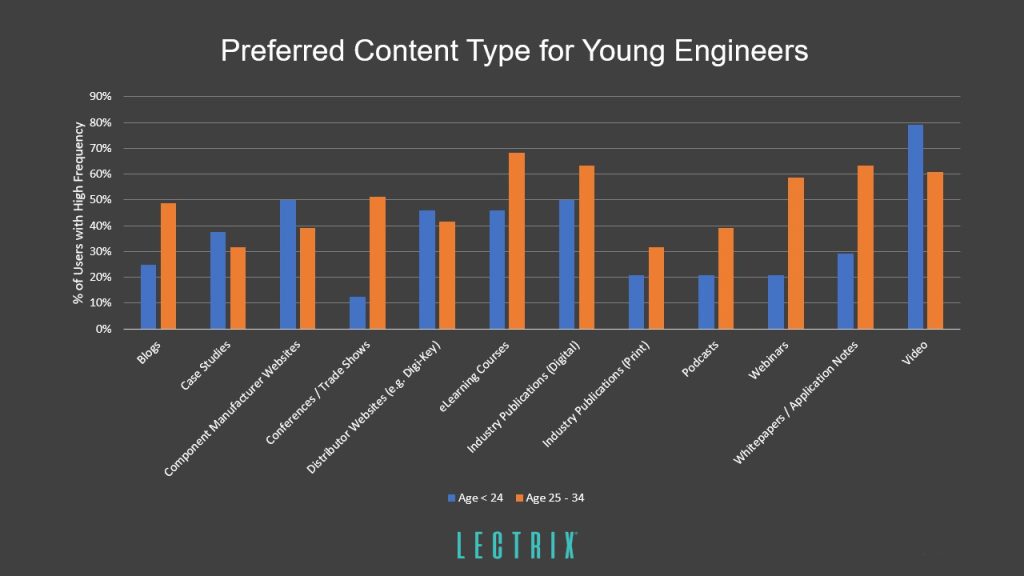In the last two years, virtually every industry at every level has needed to rethink the way it does business. With in-person meetings and events put on hold, we’ve had to reconfigure major strategies for marketing and networking.
This was an easier adjustment for some industries than others. The electronics industry, heavily reliant on physical demonstrations and word-of-mouth reputation, was left at a particular crossroads.
The truth is, however, our industry was already overdue for big changes in how we market, long before the pandemic. Now that the scene’s set and a new year has begun, what better time than now to evaluate where we are and where we can go?
Ushering in the New Generation
There are two major reasons to give electronics marketing a makeover – the first is the industry’s shifting age demographic.
For a long time, the electronics world has been “older.” In the United States, for example, the median age of electronics engineers was 45.2 in 2020, as compared to a national average of 42.5. This statistic is, however, trending younger – down from 46.2 in 2015.
Meanwhile, we’re seeing a steady increase in the number of college students earning bachelor’s degrees in electrical engineering. Despite an overall decrease in the number of students earning a BA in the US since 2010, there has been a 33.8% increase in electrical engineering degrees awarded in that same timeframe.
All this is to say, the industry is going to see greater waves of younger workers in the very near future, as current employees begin to retire.
Moving forward, new marketing strategies will be important to bridge the gap. For example, according to Limelight’s State of Online Video 2020, 42.6% of people spend 7+ hours per week on average watching online video content; 36.8% spend 2-7 hours, and just 20.6% of respondents indicated they watch 1-2 hours of online video per week.
As you can see below, the amount of time spent watching video generally decreases as age increases, suggesting video will be a worthwhile approach as the industry trends younger.
To zoom in a little further, let’s take a quick look at these results from the new Lectrix 2022 Trends in Engineering Content Survey.
When asked about online content preferences, roughly 80% of engineers under 24 and 60% of those 25-34 indicated they use video at a high frequency to engineering-related challenges.
Another interesting takeaway from this survey was a preference for eLearning courses/self-driven education in engineers under 35.
There was already a steady rise in eLearning before the pandemic began, and now CAGR is expected to grow over 21% by 2027. Our own new Lectrix survey data suggests that Millennial and Gen Z engineers will increasingly continue to take advantage of eLearning content, with roughly 70% of respondents 25-34 considering themselves users of high frequency.
For further results and analysis from our Lectrix 2022 Trends in Engineering Content Survey, tune in to the Lectrix and ECIA webinar How to Engage Young Engineers: Survey Results & Actionable Insights.
Geoffrey Forman, the Lectrix VP of Marketing, will break down the survey results in detail and what they mean for your marketing strategy. Register here – it’s live on February 23, 2022 but will be available on-demand after that date.
As younger engineers join the industry in greater numbers, it’s worth ensuring your marketing strategy aligns with younger content preferences. Utilizing the right channels is key.
More Than Pushing Products
A younger lean in the EE industry isn’t the only reason to rethink marketing style. More and more, there are signs that “traditional” new product initiative (NPI) centric marketing has begun to fall by the wayside in favor of expert, problem-solving content.
While NPI marketing is still important for brand awareness, it’s extremely difficult to use product release news alone to generate significant leads or profits.
After all, a design engineer would have to be looking for the product you are announcing at the exact time you announce it or be able to quickly remember it when needed weeks or even months later. The chances of nailing that timing are slim!
Instead, consider how you can use marketing to establish your brand as a trusted design resource, where designers find technical expertise and relevant solutions. If a designer is working on a challenging or time-crunched project, they’ll naturally want to engage with a contact who has the appropriate knowledge to help quickly and efficiently.
You only have to look at the number of EE companies adding “content marketing” to their organizational charts to see this philosophy start to be reflected in the real world.
By shifting to a marketing strategy that pushes expert content geared toward solving specific design challenges, you will see gains in both audience engagement and overall sales.
For a detailed look at one success story, check out our case study: How A Problem-First Approach to Producing Leads Earned Schaffner 25% Growth.
Between shifting demographics and a clear preference for helpful content and expertise, there has never been a better or more necessary moment to usher in a new, more successful marketing plan for your organization.



